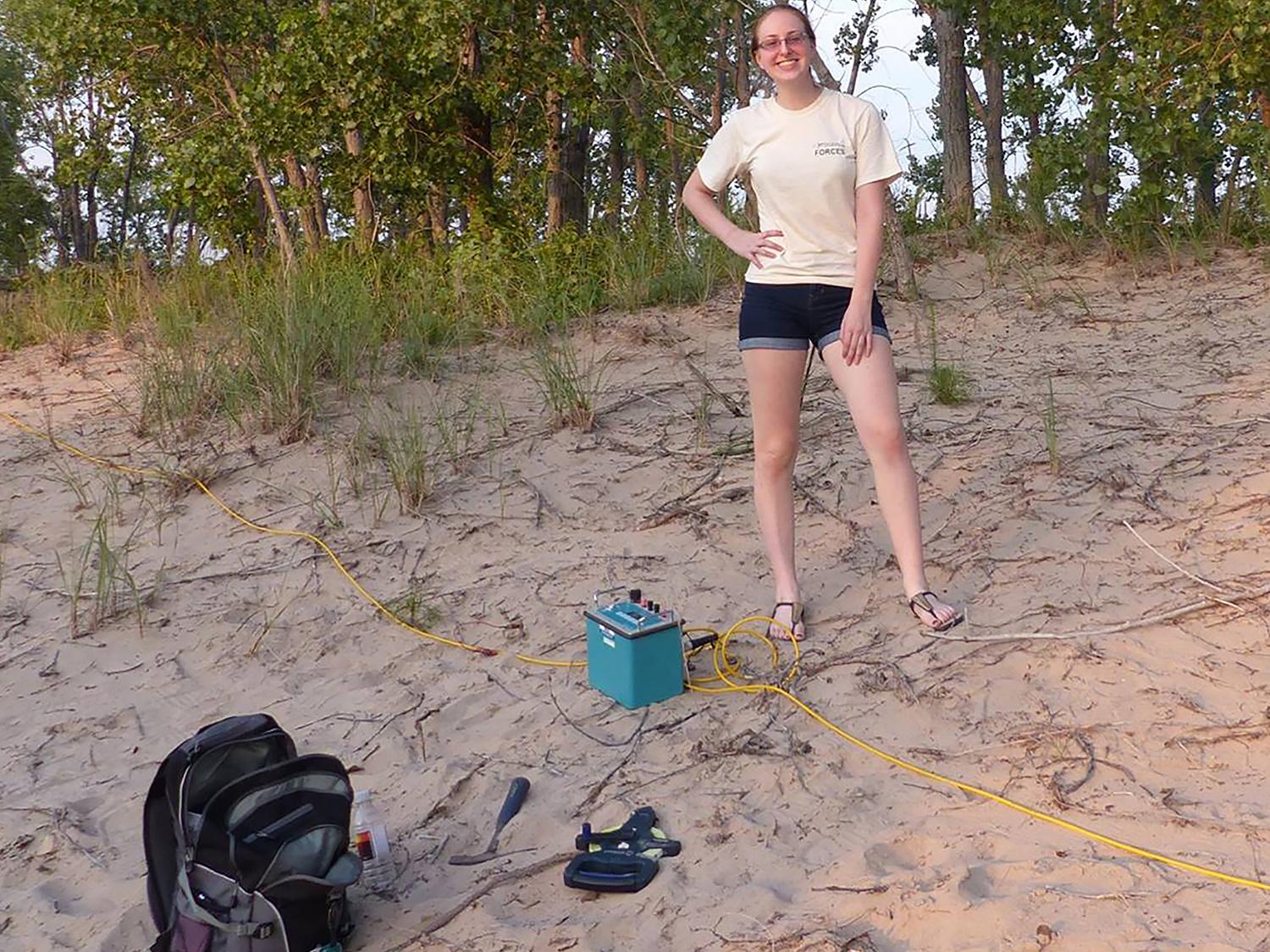High-water study -- In the dunes of Sandy Island State Park, SUNY Oswego senior geology major Kimberly Smith worked last summer on a study documenting erosion and higher groundwater levels caused by Lake Ontario's record high water level -- research she said shows damage to wildlife habitat.
The devastation SUNY Oswego geology major Kimberly Smith saw as a volunteer last summer helping with cleanup at Sandy Island State Park drove her to study the impact of high water levels on wildlife habitat in the environmentally unique dunes of eastern Lake Ontario.
The senior from Ozone Park, Queens, plans to share her findings April 4 during the scholarly poster presentation session at Quest, SUNY Oswego's daylong symposium celebrating student, faculty and staff research and creativity. Sessions are free to attend and open to the public.
"I was helping with cleanup in state parks and transplanting grasses in the dunes," Smith said. "I saw how many homes were devastated by the lake's high water level and the impact of erosion. Whole decks and other parts of homes, clothes, shoes, docks -- it was so sad."
Under the mentorship of SUNY Oswego faculty member David Valentino of atmospheric and geological sciences, Smith began a study now titled "Groundwater Table Characterization Using Electrical Resistivity in Eastern Lake Ontario Dunes During the 2016-17 Record High Lake Level Period, Oswego County, New York."
Smith focused her research, in particular, on the effects erosion has had on the dune system, including habitat alterations of piping plovers, an endangered species of seabird that, in 2015, nested successfully along the Lake Ontario shoreline for the first time in over 30 years.
"They like to eat sea critters that wash up, and build their nests based on things washed up along the shoreline," she said. "The high lake levels caused the land to erode and raised the water table under the dunes so that groundwater sometimes pooled on the surface, damaging habitat."
'A real self-starter'
Valentino, a geophysicist, trained Smith to use electrical resistivity tomography equipment and near-surface geosensing techniques. Smith set out to survey two dunes in Sandy Island State Park, northwest of Pulaski fronting North and South Sandy Pond, to map the groundwater table. She found the high water levels of 2017 "changed the internal structure of the dunes," Smith said.
Flooding over the summer meant Smith's research location was only accessible by boat. When not conducting research, she assisted park employees and volunteers establishing perimeters around nesting areas and helping with public outreach, explaining the need for the blockades on various parts of the beach to beachgoers, boaters and local homeowners.
"Kim is a real self-starter," Valentino said. "She carried out the field studies and did a beautiful job, produced an absolutely beautiful set of data."
The professor taught Smith how to process the data. The student researcher has high hopes for her study.
"It shows there's a significant problem with erosion. There are mitigating steps that are available, but it's important to take them sooner rather than later," Smith said.
"Ultimately, I hope my results will go to the DEC (state Department of Environmental Conservation) to help secure grants to rebuild and beautify the dunes," she added. "I hope it helps save the endangered species and restore the land to a more stable condition."
Smith is scheduled to present the study at the March 18 to 20 American Geological Society Conference for the Northeast, and hopes to publish it in a scholarly journal.
SUNY Oswego's annual Quest symposium encourages students to work on faculty-mentored research and creative projects in any of the college's 110 major programs of study. The experience helps them gain skills valued in graduate school and careers.
"I got more than I bargained for," said Smith. "I learned about ecosystems, how to rebuild eroded land, educating the public on environmental factors."
The researcher said she has applied to graduate schools for geology, and plans to gain her state professional geologist's license and work for the DEC or the U.S. Geological Survey.
For more information about atmospheric and geological sciences at SUNY Oswego, visit oswego.edu/ags or call 315-312-3065. To learn more about Quest 2018 -- including an upcoming schedule of presentations, times and locations -- visit oswego.edu/quest.




